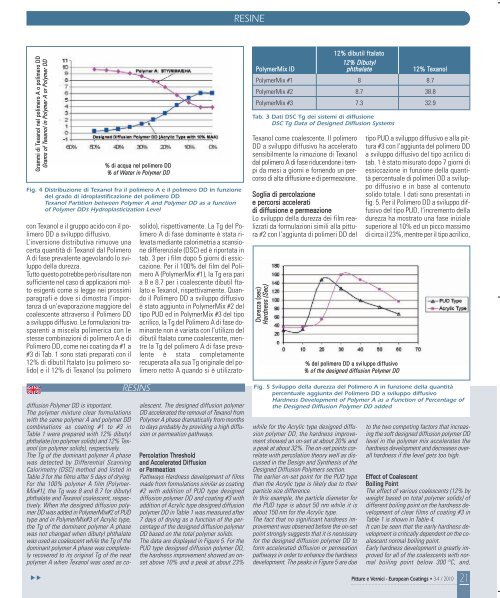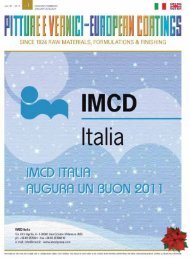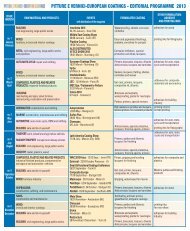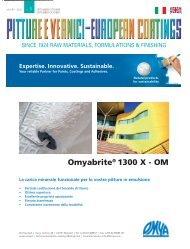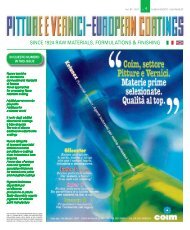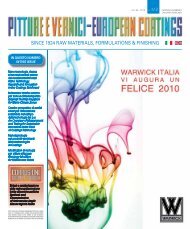Create successful ePaper yourself
Turn your PDF publications into a flip-book with our unique Google optimized e-Paper software.
Grammi di Texanol nel polimero A o polimero DD<br />
Grams of Texanol in Polymer A or Polymer DD<br />
con Texanol e il gruppo acido con il polimero<br />
DD a sviluppo diffusivo.<br />
L’inversione distributiva rimuove una<br />
certa quantità di Texanol dal Polimero<br />
A di fase prevalente agevolando lo sviluppo<br />
della durezza.<br />
Tutto questo potrebbe però risultare non<br />
sufficiente nel caso di applicazioni molto<br />
esigenti come si legge nei prossimi<br />
paragrafi e dove si dimostra l’importanza<br />
di un’evaporazione maggiore del<br />
coalescente attraverso il Polimero DD<br />
a sviluppo diffusivo. Le formulazioni trasparenti<br />
a miscela polimerica con le<br />
stesse combinazioni di polimero A e di<br />
Polimero DD, come nei coating da #1 a<br />
#3 di Tab. 1 sono stati preparati con il<br />
12% di dibutil ftalato (su polimero solido)<br />
e il 12% di Texanol (su polimero<br />
diffusion Polymer DD is important.<br />
The polymer mixture clear formulations<br />
with the same polymer A and polymer DD<br />
combinations as coating #1 to #3 in<br />
Table 1 were prepared with 12% dibutyl<br />
phthalate (on polymer solids) and 12% Texanol<br />
(on polymer solids), respectively.<br />
The Tg of the dominant polymer A phase<br />
was detected by Differential Scanning<br />
Calorimetry (DSC) method and listed in<br />
Table 3 for the films after 5 days of drying.<br />
For the 100% polymer A film (Polymer-<br />
Mix#1), the Tg was 8 and 8.7 for dibutyl<br />
phthalate and Texanol coalescent, respectively.<br />
When the designed diffusion polymer<br />
DD was added in PolymerMix#2 of PUD<br />
type and in PolymerMix#3 of Acrylic type,<br />
the Tg of the dominant polymer A phase<br />
was not changed when dibutyl phthalate<br />
was used as coalescent while the Tg of the<br />
dominant polymer A phase was completely<br />
recovered to its original Tg of the neat<br />
polymer A when Texanol was used as co-<br />
▼<br />
▼<br />
% di acqua nel polimero DD<br />
% of Water in Polymer DD<br />
Fig. 4 Distribuzione di Texanol fra il polimero A e il polimero DD in funzione<br />
del grado di idroplastificazione del polimero DD<br />
Texanol Partition between Polymer A and Polymer DD as a function<br />
of Polymer DD’s Hydroplasticization Level<br />
RESINS<br />
solido), rispettivamente. La Tg del Polimero<br />
A di fase dominante è stata rilevata<br />
mediante calorimetria a scansione<br />
differenziale (DSC) ed è riportata in<br />
tab. 3 per i film dopo 5 giorni di essiccazione.<br />
Per il 100% del film del Polimero<br />
A (PolymerMix #1), la Tg era pari<br />
a 8 e 8.7 per i coalescente dibutil ftalato<br />
e Texanol, rispettivamente. Quando<br />
il Polimero DD a sviluppo diffusivo<br />
è stato aggiunto in PolymerMix #2 del<br />
tipo PUD ed in PolymerMix #3 del tipo<br />
acrilico, la Tg del Polimero A di fase dominante<br />
non è variata con l’utilizzo del<br />
dibutil ftalato come coalescente, mentre<br />
la Tg del polimero A di fase prevalente<br />
è stata completamente<br />
recuperata alla sua Tg originale del polimero<br />
netto A quando si è utilizzato-<br />
alescent. The designed diffusion polymer<br />
DD accelerated the removal of Texanol from<br />
Polymer A phase dramatically from months<br />
to days probably by providing a high diffusion<br />
or permeation pathways.<br />
Percolation Threshold<br />
and Accelerated Diffusion<br />
or Permeation<br />
Pathways Hardness development of films<br />
made from formulations similar as coating<br />
#2 with addition of PUD type designed<br />
diffusion polymer DD and coating #3 with<br />
addition of Acrylic type designed diffusion<br />
polymer DD in Table 1 was measured after<br />
7 days of drying as a function of the percentage<br />
of the designed diffusion polymer<br />
DD based on the total polymer solids.<br />
The data are displayed in Figure 5. For the<br />
PUD type designed diffusion polymer DD,<br />
the hardness improvement showed an onset<br />
above 10% and a peak at about 23%<br />
RESINE<br />
12% dibutil ftalato<br />
12% Dibutyl<br />
PolymerMix ID phthalate 12% Texanol<br />
PolymerMix #1 8 8.7<br />
PolymerMix #2 8.7 38.8<br />
PolymerMix #3 7.3 32.9<br />
Tab. 3 Dati DSC Tg dei sistemi di diffusione<br />
DSC Tg Data of Designed Diffusion Systems<br />
Texanol come coalescente. Il polimero<br />
DD a sviluppo diffusivo ha accelerato<br />
sensibilmente la rimozione di Texanol<br />
dal polimero A di fase riducendone i tempi<br />
da mesi a giorni e fornendo un percorso<br />
di alta diffusione e di permeazione.<br />
Soglia di percolazione<br />
e percorsi accelerati<br />
di diffusione e permeazione<br />
Lo sviluppo della durezza dei film realizzati<br />
da formulazioni simili alla pittura<br />
#2 con l’aggiunta di polimeri DD del<br />
Durezza (sec)<br />
Hardness (Sec)<br />
% del polimero DD a sviluppo diffusivo<br />
% of the designed diffusion Polymer DD<br />
while for the Acrylic type designed diffusion<br />
polymer DD, the hardness improvement<br />
showed an on-set at about 20% and<br />
a peak at about 32%. The on-set points correlate<br />
with percolation theory well as discussed<br />
in the Design and Synthesis of the<br />
Designed Diffusion Polymers section.<br />
The earlier on-set point for the PUD type<br />
than the Acrylic type is likely due to their<br />
particle size difference.<br />
In this example, the particle diameter for<br />
the PUD type is about 50 nm while it is<br />
about 150 nm for the Acrylic type.<br />
The fact that no significant hardness improvement<br />
was observed before the on-set<br />
point strongly suggests that it is necessary<br />
for the designed diffusion polymer DD to<br />
form accelerated diffusion or permeation<br />
pathways in order to enhance the hardness<br />
development. The peaks in Figure 5 are due<br />
tipo PUD a sviluppo diffusivo e alla pittura<br />
#3 con l’aggiunta del polimero DD<br />
a sviluppo diffusivo del tipo acrilico di<br />
tab. 1 è stato misurato dopo 7 giorni di<br />
essiccazione in funzione della quantità<br />
percentuale di polimeri DD a sviluppo<br />
diffusivo e in base al contenuto<br />
solido totale. I dati sono presentati in<br />
fig. 5. Per il Polimero DD a sviluppo diffusivo<br />
del tipo PUD, l’incremento della<br />
durezza ha mostrato una fase iniziale<br />
superiore al 10% ed un picco massimo<br />
di circa il 23%, mentre per il tipo acrilico,<br />
Fig. 5 Sviluppo della durezza del Polimero A in funzione della quantità<br />
percentuale aggiunta del Polimero DD a sviluppo diffusivo<br />
Hardness Development of Polymer A as a Function of Percentage of<br />
the Designed Diffusion Polymer DD added<br />
to the two competing factors that increasing<br />
the soft designed diffusion polymer DD<br />
level in the polymer mix accelerates the<br />
hardness development and decreases overall<br />
hardness if the level gets too high.<br />
Effect of Coalescent<br />
Boiling Point<br />
The effect of various coalescents (12% by<br />
weight based on total polymer solids) of<br />
different boiling point on the hardness development<br />
of clear films of coating #3 in<br />
Table 1 is shown in Table 4.<br />
It can be seen that the early hardness development<br />
is critically dependent on the coalescent<br />
normal boiling point.<br />
Early hardness development is greatly improved<br />
for all of the coalescents with normal<br />
boiling point below 300 °C, and,<br />
Pitture e Vernici - European Coatings • 3-4 / <strong>2010</strong><br />
21


